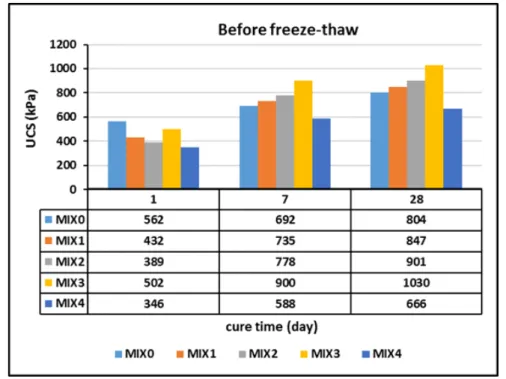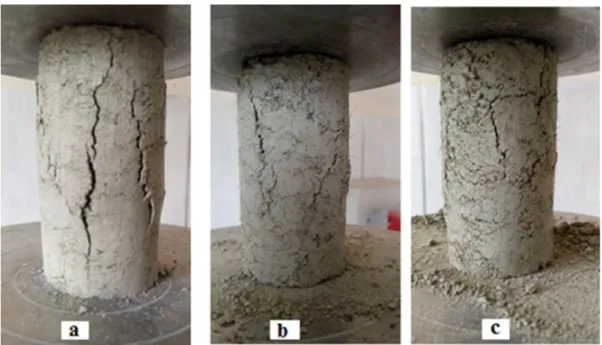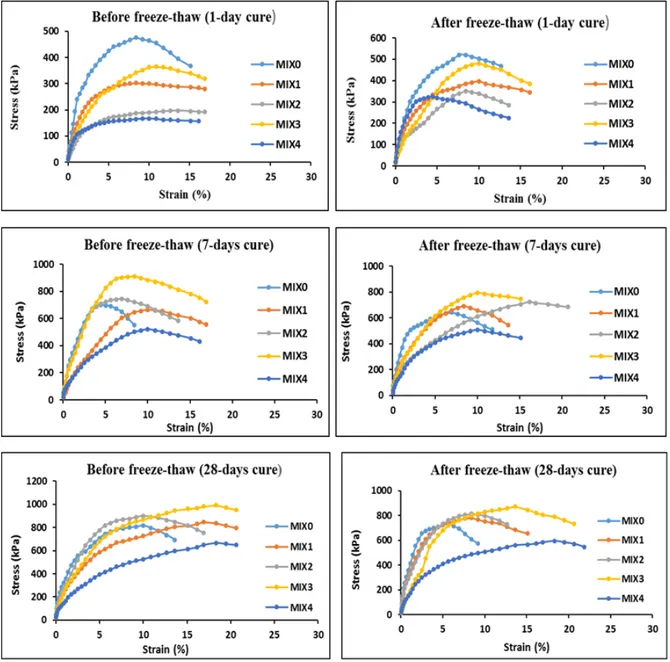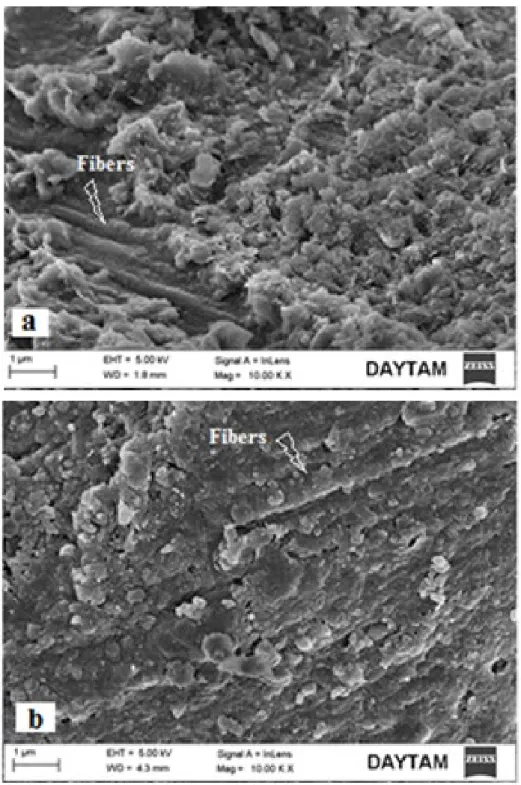DOĞAL BİR MATERYAL OLARAK KEÇİ KILI LİFLERİYLE
MODİFİYE EDİLEN KOHEZYONLU ZEMİNLERIN
DONMA-ÇÖZÜLME DİRENCİ
Necmi YARBAŞI
*,
*Atatürk Üniversitesi, Mühendislik Fakültesi, İnşaat Mühendisliği Bölümü, Erzurum, 25240, Türkiye ÖZET
Bu araştırma, doğal bir malzeme olan keçi kılı lifleri ile takviye edilmiş killi zeminin donma-çözülme testi sonucundaki dayanım değişikliklerini belirlemek amacıyla yapılmıştır. Bu çalışmada kullanılan killi zemine % 0.5, %1, %1,5 ve %2 Keçi Kılı lifleri ilave edilmiştir. İnce ve iri taneli zeminlerin doğal katkı maddeleri ile zayıf jeoteknik özellikleri güçlendirilmesi son yıllarda birçok çalışmanın ana konusu olmuştur. Bu çalışmada karışım numunelerine 1, 7 ve 28 günlük kür süresi ve 12 donma-çözülme döngüsü uygulanmıştır. Numuneler 24 saat ayarlanabilir dondurma-çözdürme kabinine -21°C'de ve +21°C'de 24 saat yerleştirilmesiyle bir döngü tamamlanmıştır. Tek eksenli basınç dayanımı testi ile eklenen katkı maddesinin killi zeminin donma-çözülme öncesi ve sonrası direncini artırdığı belirlenmiştir. En uygun karışım 28 günlük kür sonrasında Kil +%1.5 Keçi kılı lifi olarak belirlenmiştir.
Anahtar Kelimeler: Kil, Keçi kılı lifi, Mukavemet, Donma-Çözülme
FREEZE-THAW RESISTANCE OF COHESIVE SOILS MODIFIED
WITH GOAT HAIR FIBERS AS A NATURAL MATERIALS
ABSTRACT
This research was carried out to determine the strength changes in the freeze-thaw test result of clay soil reinforced with goat hair fibers, a natural material. 0.5%, 1%, 1.5%, and 2% Goat Hair fibers were added to the clayey soil used in this study. Strengthening of fine and coarse-grained soils with natural additives with weak geotechnical properties has been the main subject of many studies in recent years. In this study, curing times of 1, 7, and 28 days and 12 freeze-thaw cycles were applied to the mixture samples. A cycle was completed by placing the samples in a 24-hour adjustable freeze-thaw cabinet at -21°C and then at +21°C for 24h.It has been determined that the additive added with the uniaxial compressive strength test increase the resistance of clayey soil before and after freezing-thawing. The most suitable mixture was determined as clay+1.5% Goat hair fiber after 28 days of curing.
Keywords: Clay, Goat hair fiber, Strength, Freeze-Thaw
1. Introduction
Soil stabilization / reinforcement has been used for years to ensure the ability of soil to meet geotechnical properties. In this study, the possibility of strengthening cohesive soils with high plasticity by using goat hair fibers, which is a natural material, was investigated. An engineering structure on any lithological unit is only as durable as the foundation soil. This means that foundation ground is an important factor influencing the success of a construction project. For this reason,
understanding the geo-engineering properties of the base and subbase ground is important in terms of strength and economy.
The use of natural, synthetic or various chemicals as additives in soil stabilization/ strengthening has increased significantly in the last twenties. Work on strengthening clayey soils by adding various additives continues at an increasing speed (quartzite, obsidian, marble dust, black amber, PET, scrap rubber, polyester, coconut fiber, palm fiber, pine tree sawdust, sheep and goat wool, and human hair fibers, waste wheat straw fibers, chicken quill, etc.,)[1-17]. Many studies on the effect of these additives on the effect of changing temperatures called freeze-thaw reaction are still ongoing today. In regions where temperature changes are frequent, the balance of the existing soil can be greatly affected by this situation. Because increasing the resistance of the soil, which is exposed to constant freezing and thawing, on the freeze-thaw reaction emerges as an engineering problem[9], [11], [17-18].
Waste or residual additives used to increase stabilization, especially natural or synthetic fibers, can increase some important properties of soils with poor geotechnical properties, such as bearing capacity, shear strength, permeability, and swelling, etc. Mahdavian [19] examined keratin fibers (human hair, goat hair and sheep wool) modified with NaOH (0.1N) in terms of absorption of lead ions. These inexpensive adsorbents (absorbents) found that their surface contained human hair 33, goat hair 24, and sheep hair approximately 30 mg / g. From these results to the highest absorbency, a human hair is followed by goat hair and sheep hair. Adsorption efficiency was determined as the maximum pH = 5.8. Raja et al., [20] stated that natural fiber-reinforced composites are durable, low cost, low weight, high specific strength, non-abrasive, environmentally friendly and biodegradable. Jayaseelan et al.,[21] found that the composite material formed with the addition of goat bristle fibers and graphene increases the mechanical properties and the 37.5% fiber loading shows better mechanical properties. Tosee [22] examined the effect of goat hair on the plastic shrinkage cracks of concrete. He concluded that the addition of 1% goat hair is a suitable ratio to control shrinkage cracks in concrete, especially in lightweight concrete applications. Göktepe et al., [23] compared the Physical Properties of Anatolian Domestic Goat Hair Fibers with Kashmir in their study. The general findings obtained indicated that the hair fibers of domestic goats generally had cashmere-like properties and could be used instead of cashmere fiber in textiles. Jankowska et al.,[24] in their study; As a result of the physmechanical analysis of natural animal fibers (sheep, goat and alpaca wool), they determined that goat fibers have relatively high strength and lowest elasticity.
2. Materials and methods
2.1 Materials
2.1.1 Clayey soil (CS)
CS samples used in this study were obtained from the deposits of the Oltu Oligocene sedimentary basin, Erzurum, Northeast Turkey[25]. This clayey soil sample was obtained by excavating from a depth of 0.50 m. (Fig. 1). After drying the clayey soil samples at 55 ± 5 °C for 24 hours, the coarse grains were milled in the Los Angeles abrasive device at 6000 rpm. These samples were determined to be of high plasticity clay soils (CH) class according to the Unified Soil Classification System. The geo-engineering characteristics of CS are shown in Table 1.
Figure 1. Clay soil sample and granulometry curve Table 1. Geo-engineering characteristics of CS [3] Characteristics CS Specific weight, Gs 2.64 Sand (%) 10.0 Silty (%) 58.0 Clay (%) 32.0 Consistency limits LL, % 68 PL, % 28 PI, % 40 Compaction parameters
1Optimum water amount, % 25.8 1Max. dry weight, (kN/m3) 14.1
2Soil category CH
1Obtained from Standard Proctor Test.
2Soil class according to Unified Soil Classification System (USCS).
2.1.2 Goat hair fibers (GHF)
The sample used in this study GHF, Erzurum and its vicinity (northeastern Turkey) were obtained from hair goat race. This hair goat race is adapted to all kinds of climatic and terrain conditions of the Anatolian geography, has a strong body structure, is resistant to diseases, and is resistant to heat and cold. The ecological, economical, socio-cultural characteristics of the hair goat growing in the province of Erzurum and its immediate surroundings know this breed very closely and its breeding has been carried out for a long time[26]. This collected GHF was manually separated into fibers of the same length as 15-20 mm. The average diameter is between 18-25 µm. (Fig. 2). Goat hair is similar to wool in terms of chemical structure and properties. Due to its fine scaly surface, it is more sensitive to chemical reagents. Dilute acids do not affect the hair goat fibers but dissolve completely in concentrated acids. Its moisture absorption feature is similar to wool. It carries 16-18% moisture on these fibers[25].
Figure 2. Goat hair fibers sample and SEM image
2.2 Methods
GHF are a type of micro-reinforcement used to reinforce fine-grained floors with poor geotechnical properties. In this study, the strength changes of GHF reinforced CS as a soil improvement method the freeze-thaw (F-T) test was investigated. GHF were added 0.5%, 1%, 1.5% and 2% by dry weight of the base material (CS). Since GHF tends to clump in clay soils, care has been taken to ensure a homogeneous distribution of GHF in the mix. Samples were first compressed with the Standard Proctor Test at optimum water content (ASTM D. 698-78) then cylindrical samples of 3.5 cm diameter and 7.0 cm height were created with samplers. Mixing ratios are 100% CS (MIX0), 99.5% CS + 0.5% GHF (MIX1), 99% CS + 1% GHF (MIX2), 98.5% CS + 1.5% GHF (MIX3) and Is 98%. CS is + 2%. GHF (MIX4). After determining the optimum water content of the mixtures with the Standard Proctor Test, a working program was planned for the free pressure and F-T test. On account to investigate the consistency of the strength results of the mixtures of MIX0, MIX1, MIX2, MIX3 and MIX4 after 1, 7 and 28 days of curing, before and after (F-T), three (3) cylindrical samples were prepared for each mixture.
Unconfined compressive tests were performed in according to ASTM D 2166 standard. Load-deformation readings were recorded by a computer controlled system, taking into account the 0.5 mm/min increase in deformation. F-T experiments were carried out with a closed system device capable of forming freeze-thaw cycles (ASTM D 5918). In the experiments, the freezing temperature is -21oC and the thaw temperature is +21oC. The waiting time between the freezing and thawing cycles was set as 24 hours. This F-T cycle was cured for 1, 7 and 28 days, followed by a total of 12 cycles, repeating consecutively. It was repeated 12 times. This operation was named cycle 1 [4], [8], [14],[18]. Samples that completed the F-T cycles were subjected to the UCS. In this study, the maximum fiber length was cut manually into pieces of 15-20 mm length using scissors. XRD and SEM analysis for D8 AXS XRD Spectrometer and Sigma 300 Zeiss Gemini FE-SEM devices are used (Atatürk University were made in High Technology Research and Application Center Laboratory (Erzurum, Turkey).
3 Experimental results
3.1 Unconfined compressive strength (UCS)
F-T test values of CS specimens equipped with GHF were determined by the free pressure tester. Before F-T, the highest strength values of MIX1, MIX2, MIX3 and MIX4 mixtures were
Figure 3. UCS distribution before F-T
The highest strength values of MIX1, MIX2, MIX3 and MIX4 mixes after F-T were obtained after 28-days curing. When these values are compared with the reference material (CS); 4.76%, 10.61%, 25.17%, and 14.83%, rates increases were detected respectively. According to experimental results, GHF used in the improvement of CS samples is an important factor. UCS values generally increased by 0.5%, 1% and 1.5% of GHF, while a 2% decrease was detected (Fig. 4).
Before and after F-T, there was an increase in strength when adding GHF additive at 0.5%, 1% and 1.5%, while a decrease in strength occurred at the addition of 2% GHF. The reason for these reductions is not being able to establish sufficient bonds between GHF and clay grains, and GHF, which has a high water absorption capacity, reduces the water content of the clayey soil, and loses its water in increasing cure times, thereby weakening the bonds. Similar results were obtained in Galán-Marín et al.,[28-29], Yarbaşı [17], Broda and Gawlowski[16]. When the F-T test strength values of the mixtures were compared, decreases of 11.03%, 12.02%, 10.46% and 13.58% were observed, respectively. It has been determined that this reduction rate is at least 10.46% in the mix of MIX3.
According to test results, all GHF reinforced CS samples show better strength performance than non-reinforced CS samples. This increase in UCS increases with curing time and GHF rate. Also, swellings occurred in the middle part of the GHF reinforced CS samples. This situation is defined as the bridging effect, which is one of the important factors that increase the strength and ductility of the mixture (Fig. 5). Similar studies were carried out by Zaimoglu and Yetimoglu [30] and Yarbaşi [17].
Figure 5. The surface deformation of samples at the failure moment; unreinforced CS sample (a) and SWF-reinforced CS samples (b and c).
3.2 Stress-strain (deformation) correlations
The stress-strain behavior of the F-T test cycles of the specimens were tested under a single axial pressure at a constant axial strain rate (0.5 mm/min). Although 0.5%, 1% and 1.5% of GHF added to CS showed a significant increase in strength, a 2% reduction in strength was observed. For this reason, adding fiber to such soils (0.5%, 1%, and 1.5%) increased the UCS by changing the deformation behavior of the specimens under constant load, decreased the amount of strength reduction after the peak value was surpassed. In the case of a 2% GHF mixture, it can be said that this decrease in strength decreases the friction resistance between clay soil particles with high plasticity and causes a decrease in UCS[31]. This work also deals with the first tangent modules representing the initial slope of the stress-strain curves. In samples with a curing time of one day, the first tangent modules before and after freeze-thaw are very close to each other. This indicates that the initial hardness of the ground is not affected by the GHF contribution. It also shows that a one-day cure is not enough to complete the reactions between clay and GHF. However, when the slopes are compared in seven and twenty-eight cycles, it is clear from figure 6 that the initial tangent modulus increases with the length of the cure time and the increase in the GHF ratio. At the end of the seven and twenty eight
stress-strain graphs shown in Fig. 6, the peaks of the values before and after thawing are considered to be more common and this is a result of the transition to ductility. This behavior change, seen as an increase in ductility, and compressibility, is thought to be due to the water absorption capacity of the water lenses and GHF in the pores.
Figure 6. Stress-strain graphs before and after F-T
As a conclusion, it is clearly seen that in stress-strain curves GHF increases the peak compressive strength and ductility of CS under static load. This shows that a more significant improvement is provided for the 28-days curing period. Similar conclusions were seen in the studies of Zaimoglu et al.,[9], and Yarbaşi[17]. One of the important factors that increase the strength of fiber-reinforced samples is the bridging effect. GHF reinforcements, which provide the connection of two fracture planes, increase the ductility and prevent sudden fractures. This situation can be seen in Figure 5. In addition, Zaimoğlu and Yetimoglu [30] defined in their studies on this subject that the bridging effect is effective on both strength and ductility.
3.3 SEM correlations
Possible changes in the structure of clay soil mixtures reinforced with GHF were investigated by SEM imagery. In Fig. 7(a), it was seen that GHF added to clayey soil was in a harmonious relationship with the clay matrix before F-T. This compatibility is thought to be due to chemical components and the positive interaction of GHF with water [16], [28-29]. When the SEM image after F-T is examined in Figure 7 (b), It is seen that there is not much structural change but some local gaps occur. It is thought that the ice lenses formed in the pores form these spaces. Similar comments were also stated in the studies of Yu et al.,[32], and Yarbaşi[17].
In this study, the strength effect of F-T on CS reinforced with GHF, a natural material, was investigated. As a result of experimental studies, it has been determined that GHF additive increases the strength of CS before and after F-T. Curing time and the increase in the GHF additive rate played an important role in this rising. The highest increase in strength was seen in the mixture of CS+1.5% GHF (MIX3) and at 28-day of cure. While the strength increase rate before F-T was 68.67% in this mixture this increase rate was 62.67% after F-T. The addition of GHF to CS samples was observed in stress-strain plots where the mixture not only increased ductility before F-T but also helped maintain ductility behavior after F-T. In addition, the swelling percentage of the CS sample with swelling property decreased from 18.18% to 3.64% with the addition of 2% GHF. This showed that GHF has a good water absorption capacity. This situation was also observed in SEM images. As a result, GHF offers many advantages such as increasing strength and ductility, lowering swelling pressure, low cost, and slow rotting process. Therefore, I believe GHF can be used as a sustainable and environmentally friendly material that reduces stabilization costs.
Referances
[1] Prabakar J, Sridhar RS. “Effect of random inclusion of sisal fiber on strength behavior of soil”. Construction and Building Materials, 16(2002):123–31.
[2] Zheljazkov VD. “Assessment of wool waste and hair waste as soil amendment and nutrient source”. Journal of Environmental Quality, 2005, 34(6), 2310–2317.
[3] Akbulut S, Arasan S, Kalkan E. “Modification of clayey soils using scrap tire rubber and synthetic fibers”. Applied Clay Science, 2007,38(1–2) : 23–32.
[4] Yarbaşı N, Kalkan E, Akbulut S. “Modification of the geotechnical properties, as influenced by freeze-thaw, of granular soils with waste additives”. Cold Regions Science and Technology, 2007, 48(1), 44-54.
[5] Hejazi SM, Sheikhzadeh M, Abtahi SM, Zadhoush A. “A Simple Review of Soil Reinforcement by Using Natural and Synthetic Fibers”. Construction Building Material, 30(2012), 100–116. [6] Maliakal T, Thiyyakkandi S. “Influence of randomly distributed coir fibers on the shear strength
of clay”. Geotechnical Geology Engineering, 31(2012):425–433.
[7] Ayothiraman R, Bhuyan P, Jain R. “Comparative Studies on Performance of Human Hair and Coir Fibers against Synthetic Fibers in Soil Reinforcement”, presented at the Third Annual International Conference on Architecture and Civil Engineering (ACE 2014), 222–227, Singapore, 2014.
[8] Yarbasi N. “The freezing-thawing behavior of clayey soils reinforced with scrap tires pieces”. Pamukkale University Journal of Engineering Sciences, 2016, 22(6), 559-562.
[9] Zaimoglu AŞ, Akbulut RK, Arasan S. “Effect of Freeze-Thaw Cycles on Strength Behavior of Compacted Chicken Quill-Clay Composite in Undrained Loading”. Journal of Natural Fibers,13(2016): 3, 299-308.
[10] Narayanan KS, Sharmila SMR.“Stabilization of Clay with Human Hair Fiber”. International Journal of Civil Engineering and Technology (IJCIET), Volume 8, Issue 4, pp. 664-668. 2017. [11] Yarbasi N, Alacali M. “Investigation on the variation of strength of coarse grained soils
reinforced with waste tires pieces as a result of freezing and thawing cycles”. Pamukkale University Journal of Engineering Sciences, 2018, 24(3), 561-565.
[12] Aygun Z, Yarbasi N. “Analyses of the Structural and the Temperature-Dependent Magnetic Properties of Pine Resin and Pine Bark from the Oltu/Erzurum Region in Turkey”. Journal of the Korean Physical Society, 2018, Vol. 72, No. 7, pp. 795-799.
[13] Tosee VR. “Different Percentage of Bagass And Hair Of Goat In Concrete Slab: Application, PSC Reduction, and Strength”. Soil Structure Interaction Journal (SSIJ) 2018, Vol. (1), 47-52. [14] Yarbasi N. “Performance of granular soils reinforced with obsidian (volcanic glass) additives in
different proportions subjected to freeze-thaw”. Pamukkale University Journal of Engineering Sciences, 2019, 25(6), 764-767.
[15] Jankowska D, Wyrostek A, Patkowska–Sokoła B, Czyż K. “Comparison of Physico-mechanical Properties of Fibre and Yarn Made of Alpaca, Sheep, and Goat Wool”. Journal of Natural Fibers, doi: 10.1080/15440478.2019.1691126
[16] Broda J. Gawlowski A. “Influence of Sheep Wool on Slope Greening”. Journal of Natural Fibers, 2020,Vol. 17, Issue 6, 820-832.
[17] Yarbaşi N. “Effect of Freezing-Thawing on Clayey Soils Reinforced with Human Hair Fibers”. Journal of Natural Fibers, 2020, 17(6), 921-931.
[18] Ghazavi M, Roustaei M. “The influence of freeze–thaw cycles on the unconfined compressive strength of fiber-reinforced clay”. Cold Regions Science and Technology, 2010, 61(2): 125-131. [19] Mahdavian L. “Effects of magnetic field, pH and retention time on the lead (Pb2+) adsorption by
modified human hair, goat hair and sheep wool”. African Journal of Microbiology Research, 2012, Volume 6 (1), 183-189.
[20] Raja T, Anand P, Karthik M, Sundaraj M. “Evaluation of Mechanical Properties of Natural Fibre Reinforced Composites – A Review”, International Journal of Mechanical Engineering and Techonolgy, 2017, 8(7), 915–924.
[21] Jayaseelan J, Vijayakumar KR, Ethiraj N, Sivabalan T, Andrewnallayan W. “The effect of fibre loading and graphene on the mechanical properties of goat hair fibre epoxy composite”. IOP Conference Series: Materials Science and Engineering, Volume 282, Busan, Korea, 2017. [22] Tosee VR. “Different Percentage of Bagass And Hair Of Goat In Concrete Slab: Application,
PSC Reduction, and Strength”. Soil Structure Interaction Journal (SSIJ) 2018, Vol. (1), 47-52. [23] Göktepe F, Canipek G, Soysal MI. “The Comparison of Physical Characteristics of Anatolian
Native Goat Down Fibers With Cashmere”. Textile and confection, 2018, 29 (1), 11-21.
[24] Jankowska D, Wyrostek A, Patkowska–Sokoła B, Czyż K. “Comparison of Physico-mechanical Properties of Fibre and Yarn Made of Alpaca, Sheep, and Goat Wool”. Journal of Natural Fibers, doi: 10.1080/15440478.2019.1691126
[25] Kalkan E, Bayraktutan M. “Geotechnical evaluation of Turkish clay deposits: a case study in Northern Turkey”, Environmental Geology, 2008, 55 (5), 937-950.
[26] Kudaka. “Ovine breeding in the province of Erzurum”. Northeast Development Agency, Sectoral Research Report, (EYDO/SAR/17/01), Erzurum, Turkey, 2017.
[27] MEB. Textile Technology, Ministry of National Education, Ankara, Turkey, 2014.
[28] Galán-Marín, C, Rivera–Gómez C, Petric-Gray J. “Clay-based composite stabilized with natural polymer and fiber. Construction and Building Materials, 2010a, 24 (8): 1462–1468.
[29] Galán-Marín, C, Rivera-Gómez C, Petric-Gray J. “Effect of animal fibers reinforcement on stabilized earth mechanical properties”. Journal of Biobased Materials and Bioenergy, 2010b, 4(2):121–128.
[30] Zaimoglu AS, Yetimoglu T. “Strength behavior of fine grained soil reinforced with randomly distributed polypropylene fibers”. Geotechnical and Geological Engineering, 2012, 30 (1):197– 203.
[31] Eskisar T, Altun S. “Experımental Investıgatıon On Mechanical Behavior of Fiber Reinforced Fine Grained Soils by Unconfined Compression Tests”. 6. Geotechnical Symposium, Çukurova
University, Adana, Turkey, 26-27, 2015.
[32] Yu Y, Yang W, Wang B, Meyers MA. “Structure and mechanical behavior of human hair”. Materials Science & Engineering. C, Materials for Biological Applications 73(2017): 152–63.





